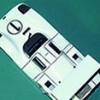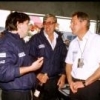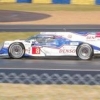Can-Am cars fastest in a straight line?
#1

Posted 12 June 2009 - 23:22
Advertisement
#2

Posted 13 June 2009 - 00:58
I am sure the TNF cognoscenti will have other examples too; presumably your author doesn't count dragsters ?
Edited by jsummers502, 13 June 2009 - 00:59.
#3

Posted 13 June 2009 - 01:52
But, of course, those weren't Can-Am cars.
Edited by Direct Drive, 13 June 2009 - 01:54.
#4

Posted 13 June 2009 - 03:22
Since these two cars were within 2-3 years of each other and they had not put in any chicanes yet I would love to have seen what the 917/30 could have done at the Le Mans coarse. The turbo era of F1 cars could have been faster to 100 and i'm sure there are some current cars that are but they most likely could not match the top speed of the 917/30. Giving it 8 miles and 1200+ HP to cut loose with is a very exciting thought that gives me goose bumps and something to dream about and i'm sure Mark would have been up for giving it a try but alas it's one of those what if things. I do know that the 917/30 held the closed coarse speed record for many years until A.J. Foyt broke the record in a Buick powered car. I was lucky enough to see the 917/30 race back in the day and have seen it race at Vintage events but even with Hans Stuck at the wheel it was not driven with at the speeds of back in the day. Vintage events are great for being able to see these wonderful machines but alas non of the current owners have the ability or the fortitude to drive them like they did back in the day. In fact the only exception was last year at the Monterey Historics Mario Andretti dorve his Championship Lotus around Laguna Seca with the same gusto as back in 1978 it was way faster than any vintage racer i've ever seen drive their car it was a real treat.
#5

Posted 13 June 2009 - 08:48
That may have been correct when the book was written, but it didn't sound right to me, and indeed a little bit of surfing indicated that the chicanes were introduced on the Mulsanne Straight at Le Mans specifically due to cars going quicker than 400 km/h ( 248mph), namely the Peugeots.
I think it was the WM-Peugeot cars that were most often clocked at over 240mph on the old, chicane free, Mulsanne during the late 1970s/early1980s when I used to go to Le Mans every year. Indeed one year, I remember, they made a special attempt to set some sort of record and reached over 251mph.
After a 4th place in 1980, their whole approach seemed to be become one of being the fastest through the speed trap - they rarely seemed to last more than an hour or so in the race. I do recall that the morning copy of the local paper often featured a photo of a WM heading down the escape road at Mulsanne corner.
Sadly the WM team were involved in tragedy on the Mulsanne in 1981 " when at 16h06 Thierry Boutsen suffered a massive accident just after the Hunaudières kink, some 400 meters before the Mulsanne bosse (the "hump") when his WM P81-Peugeot was traveling at some 350 km/h. A suspension piece had failed and the car hit the guard-rail losing the entire rear end. Boutsen was untouched, but the debris field of hurled parts and bodywork was spread over 150 meters. Three marshals were struck by the debris. One of them, Thierry Mabillat was killed, struck in the chest by a detached piece of the guard rail. Two of his colleagues were seriously injured, Claude Hertault and Serge David, who lost an arm". - source Motorsport Memorial.
Tony
Edited by taylov, 13 June 2009 - 08:57.
#6

Posted 13 June 2009 - 09:15
#7

Posted 13 June 2009 - 09:49
That may have been correct when the book was written, but it didn't sound right to me, and indeed a little bit of surfing indicated that the chicanes were introduced on the Mulsanne Straight at Le Mans specifically due to cars going quicker than 400 km/h ( 248mph), namely the Peugeots.
I am sure the TNF cognoscenti will have other examples too; presumably your author doesn't count dragsters ?
I always understood it was because Balestre was pissed off with ACO for not falling into line with his rules and he thought by banning any straight longer than a mile, or whatever, he would do for Le Mans
#8

Posted 13 June 2009 - 10:24
And check this out: Honda on speed in 2006
I saw something about it on the telly.
#9

Posted 13 June 2009 - 18:50
#10

Posted 13 June 2009 - 20:27
Henry
#11

Posted 14 June 2009 - 10:30
#12

Posted 14 June 2009 - 11:45
What about the outlawed Can-Am rocket?

Henry
The 917-30
http://www.conceptca...che-917/30.aspx
The term "rocket" is my interpretation.
Imagine this one in a straight line and not on banking at Talladega.
Henry
#13

Posted 14 June 2009 - 19:30
It is very unfortunate that these cars were never allowed to race at Le Mans.
#14

Posted 25 August 2009 - 21:40
On the Paul Ricard straight Patrick Tambay at the wheel of his F1 Ferrari Turbo 1982 was clocked at 347 Kmh (217 mph) : the Mistral straight was 1,8 Km long (1,12 miles ) and a 700 hp output was assumed for its 1500cc turbo engine.
At Monza,out of Parabolica curve F1 speeds were around 260 Kmh and Barrichello's Ferrari F1 3000 topped a nice 370 ( 231 mph)at the braking point before entering the 1st chicane:the straight is no more than 1 Km.long .
Again,if memory helps,Henry Pescarolo alongside with codrivers were clocked at over 400 Kmh on Le Mans straight in the early 80es at the wheel of a nearly homemade sport car.
O also recall a Mugen Honda F1 (3000cc - 800 Hp approx.) having undergone a pure speed test on a wide smooth surface (similar to Salt Lake plain):driven by a southafrican tester a top speed slightly over 400 Kmh (250,6 mph) was seen.
In recent times,at Nardò highspeed test circuit, a bunch of 997 Turbos by various german tuners (Ruf etc.)were clocked over 360 kmh (225 Mph) in a nearly road going trim ....
---
All this said, I guess that the monster 917 Can Am could even outclass its own record if tested on a straight: that would allow a lower charge on the wide back wing and speed could increase of a full 5 miles give or take. I'm not aware if the test required a great charge on the back flap back then:quite a different set up could be needed.
Obv. it's beyond the point that,so I could read years ago,on the event,the turbos' pressure had been overboosted being a short term test:breathtaking though.
#15

Posted 25 August 2009 - 23:04
HI! talking about high speeds back in the late 60es the 917 long tail topped 385 kmh regularly (240 mph) on Le Mans straight,which was at least 11 miles long if memory serves,
The total circuit length in the early '70s was 8.475 miles. I believe that the pre-chicane Mulsanne was around three miles long.
#16

Posted 25 August 2009 - 23:36
#17

Posted 26 August 2009 - 02:21
The total circuit length in the early '70s was 8.475 miles. I believe that the pre-chicane Mulsanne was around three miles long.
HI ! You're right: in its various shapes during the decades from 1930 to the late 80es that was approx.the total lenght ! And yes the straight was around 3,5 / 4 miles long.
#18

Posted 26 August 2009 - 02:52
I thought I remember hearing that the 917/30 hit 257 at Paul Ricard...
Edited by stevewf1, 26 August 2009 - 03:21.
#19

Posted 26 August 2009 - 10:20
They were built for speed, not endurance.
Advertisement
#20

Posted 26 August 2009 - 14:49
The WM Peugeot did 241mph, IIRC, when I was there in '81...
They were built for speed, not endurance.
If my memory serves me well, in the last year of the chicaneless Mulsanne, the Sauber-Mercedes were close to 400 and achieved it much easier then the team expected it would be, given the downforce they applied for the corners.
henri
#21

Posted 26 August 2009 - 15:49
'The Unfair Advantage' (Donohue/van Valkenburgh) suggests 240mph, 'Porsche racing cars of the 70s' (Paul Frere) says 231mph.
Both are for the improvised 'long tail'; whilst wanting to minimize drag and mitigate losses on the straights, I don't imagine out-and-out top end speed was their priority. Surely nowhere they planned to race had a straight like the Mistrale?
#22

Posted 26 August 2009 - 18:08
Nothing better that brute horsepower.
http://www.aerowarriors.com/bv.html
Henry
#23

Posted 26 August 2009 - 22:43
Back in the 70s & 80s, almost every year in practice at Monza, some team would have a go at running without a rear wing. Sure, they went faster in a straight line, but lap times rarely reflected this, they were losing so much elsewhere, that the gain was lost. Also, most of the drivers involved said that the cars felt "scary", and it wouldn't have been a practical proposition for the race, but that never stopped someone else trying the same thing next year, only to reach the same conclusion.
Are you sure? I don't recall seeing much/any photographic evidence of this.
Rindt's accident was often attributed to the fact he was running without a rear wing but that was in 1970, in the days before the chicanes (post 1971) seriously limited really high speeds at Monza.
#24

Posted 26 August 2009 - 23:00
Are you sure? I don't recall seeing much/any photographic evidence of this.
Rindt's accident was often attributed to the fact he was running without a rear wing but that was in 1970, in the days before the chicanes (post 1971) seriously limited really high speeds at Monza.
The late Maurice Philippe told me that the cause of Rindt's accident was incorrect gun drilling on the brake shafts. They were gun drilled from both ends and a discontinuity in the middle caused a stress raiser which weakened the shafts.
#25

Posted 27 August 2009 - 09:00
Are you sure? I don't recall seeing much/any photographic evidence of this.
Rindt's accident was often attributed to the fact he was running without a rear wing but that was in 1970, in the days before the chicanes (post 1971) seriously limited really high speeds at Monza.
Well yes, I am sure, but like you I don't recall seeing many photos, it was certainly mentioned in the Autosport GP write-ups though. Maybe if Pete Lyons sees this thread, he could tell us what he remembers on the subject.
#26

Posted 27 August 2009 - 09:38
Yes, I recall this was the reason that eventually emerged. At the time it was all being denied and fingers were pointed at what may have been Rindt's own decision to run without a wing on a car designed around them. The 72 was reported to be very wobbly under brakes and I guess it was easier for the press to go with that, and apportion some of the 'blame' to the driver himself than to risk the possibly libelous suggestion of a componant failure.The late Maurice Philippe told me that the cause of Rindt's accident was incorrect gun drilling on the brake shafts. They were gun drilled from both ends and a discontinuity in the middle caused a stress raiser which weakened the shafts.
#27

Posted 27 August 2009 - 12:09
Are you sure? I don't recall seeing much/any photographic evidence of this.
I remember a piece in the 1988 Season Review where Williams tried to run a very low rear wing on the car at Hockenheim. Eventually, they ran the regular rear wing on both cars in the race.
#28

Posted 27 August 2009 - 13:15
If it's just about which racing car went fastest in a straight line, then the Le Mans WM-Peugeots would count in this category (first past 400kph in 1988) as well as various closed circuit speed record attempt vehicles such as the Porsche 917/30 at Talladega. I'm also suprised that nobody's mentioned the BAR F1 team (or was it Honda by then?) who ran a special trimmed-out version at Bonneville a few years ago. Alan van der Merwe was the driver but I can't remember what speed it got up to.
More impressive to me are the circuit racers, going about their business of getting round a lap as fast as possible in a race, who just happen to go very quickly. Technically the later WMs were in this category (1987-89) but were designed for top speed only and just happened to be in the race. The 1988 Jags did around 248mph in the race and the Sauber-Mercedes were even quicker the following year. Both won the race of course, whilst having to negotiate tight corners such as Arnage and the Ford chicanes. I'd also class de Ferran's Indycar in this category.
Of course the only cars that could possibly qualify in this category are those that either race on superspeedway ovals, or circuits with very long straights. Ultimately top speed is a trade-off between drag, downforce and gearing so it's (literally) horses for courses. Nevertheless it's fair to say that the late-80s Le Mans cars had the best potential in terms of their aerodynamic shapes and engine performance for achieving the highest straight line speed (IMHO!)
Peter
























